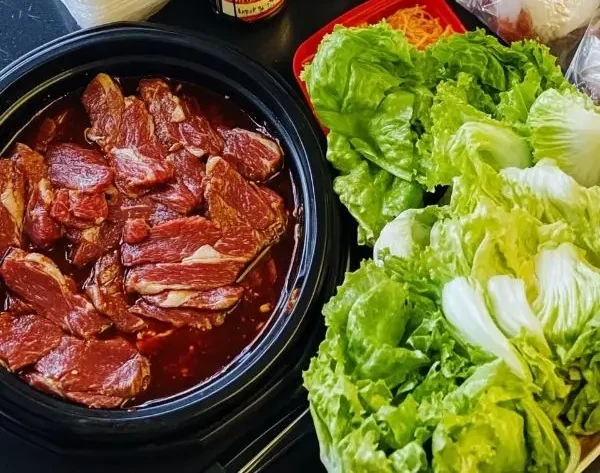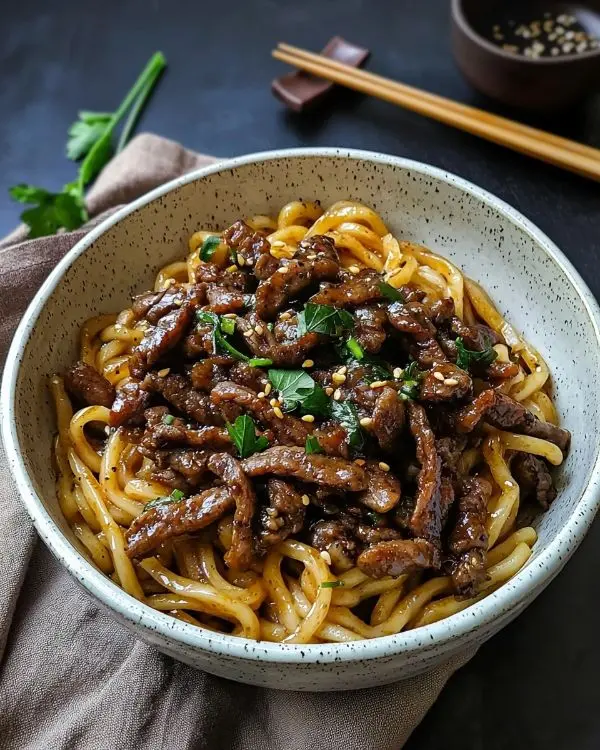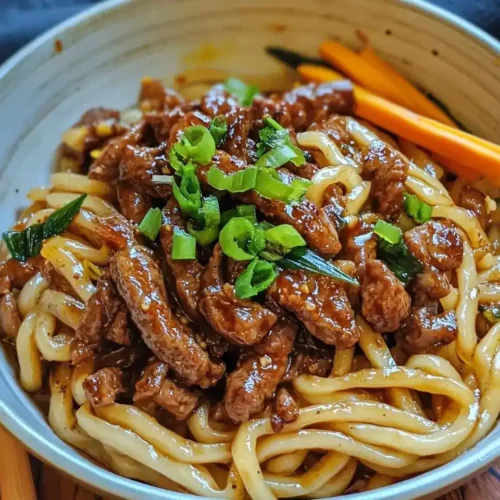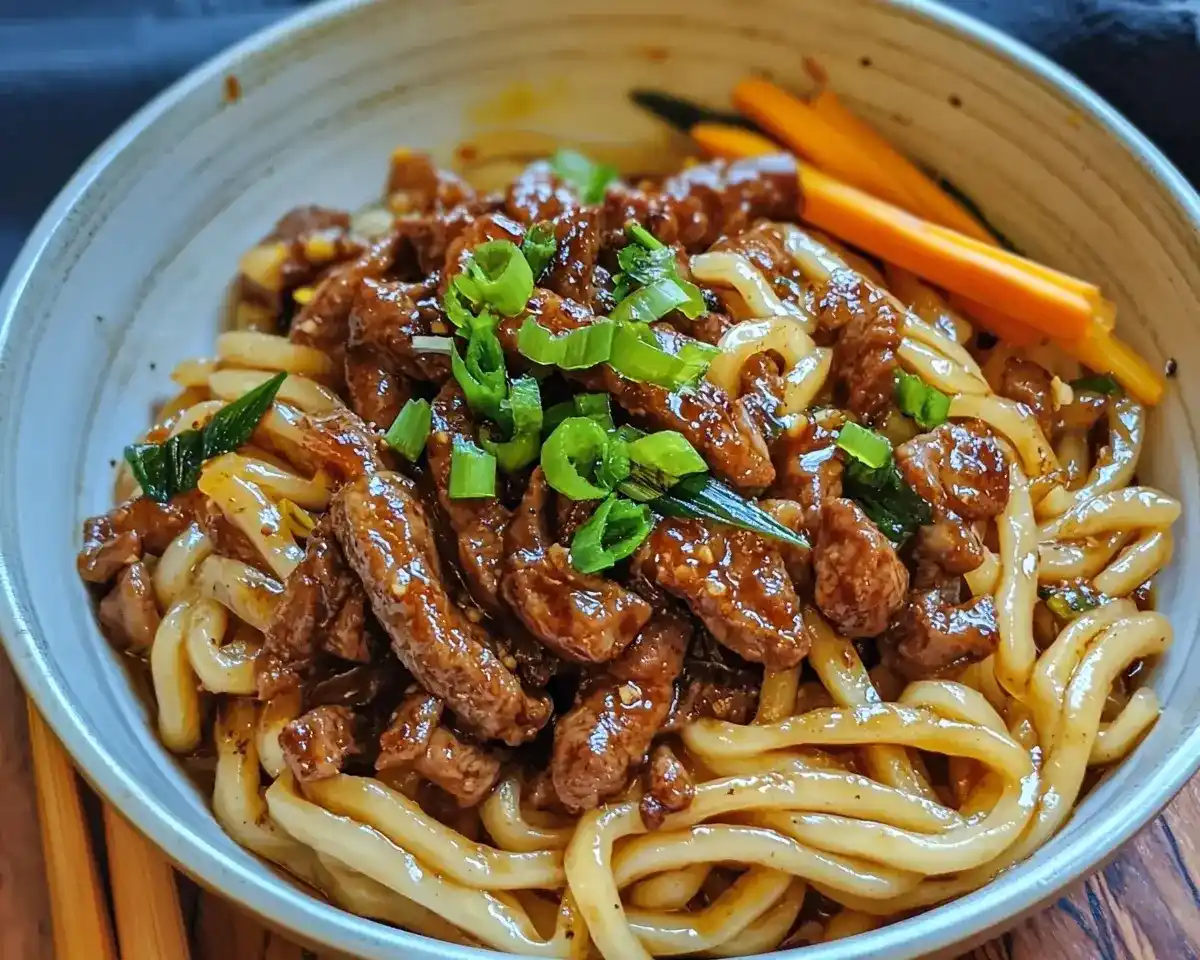Quick Beef Black Pepper Udon recipe with tender marinated beef, bold black pepper sauce, and bouncy noodles ready in 15 minutes.
Hi, I’m Linda, and welcome to Tasty at Home—a cozy corner where bold flavors meet everyday kitchens. Last Tuesday night, I stood in my kitchen staring at leftover beef and a packet of udon noodles, wondering how to turn them into something spectacular. Well, let me tell you, one bite of this Quick Beef Black Pepper Udon transported me straight to the bustling noodle shops of San Francisco’s Chinatown, where the aroma of black pepper and soy sauce fills the air like a warm embrace.
I’ve tested this recipe eight times—overcooked the noodles twice and learned the hard way that timing is everything—so you don’t have to make the same mistakes. Whether you’re craving authentic Chinese flavors or need a lightning-fast weeknight dinner, this recipe delivers both comfort and excitement in every slurp. The tender marinated beef paired with that bold black pepper sauce creates a symphony of flavors that’ll have your family asking for seconds.
Because here at Tasty at Home, every dish tells a story—and this one might just become your new Tuesday night tradition.
Table of Contents
What Makes This Black Pepper Beef Udon Special
This Flavorful Beef Black Pepper Udon stands apart from typical stir-fry noodles because of three key elements. First, the beef marinates in a carefully balanced mixture that includes Chinese white rice vinegar—a secret ingredient that tenderizes the meat while adding subtle complexity. Additionally, the black pepper sauce uses dark soy sauce instead of regular soy, creating that rich, glossy coating that clings perfectly to the bouncy udon noodles.
Most importantly, this recipe respects the integrity of each component. The noodles stay al dente, the beef remains tender, and the vegetables retain their crunch. You know how some stir-fries turn into mushy disappointments? Not this one.
After developing this recipe through countless kitchen experiments, I’ve discovered that timing trumps technique every time. Furthermore, using fresh-ground black pepper instead of pre-ground makes an enormous difference in flavor intensity.
Essential Ingredients for Perfect Black Pepper Beef Udon Results

| Main Ingredients | US Measurement | Metric |
|---|---|---|
| Udon noodles (fresh or frozen) | 2 packs | 400g |
| Fresh beef (sirloin or flank steak) | 7 oz | 200g |
| Chinese cabbage | 4 cups, chopped | 300g |
| White onion | 1 medium, sliced | 150g |
| Garlic | 1 tbsp, minced | 15g |
| Beef Marinade | US Measurement | Metric |
|---|---|---|
| Garlic | 1 clove, minced | 3g |
| Sesame oil | 1 tsp | 5ml |
| Soy sauce | 1 tbsp | 15ml |
| Oyster sauce | 1 tsp | 5ml |
| Cornstarch slurry | 1 tsp + water | 5g |
| Chinese white rice vinegar | 1 tsp | 5ml |
| Black Pepper Sauce | US Measurement | Metric |
|---|---|---|
| Dark soy sauce | 3 tbsp | 45ml |
| Oyster sauce | 1 tbsp | 15ml |
| Fresh ground black pepper | 2 tsp | 4g |
| Water | 3 tbsp | 45ml |
| Potato starch | 1/2 tsp | 2g |
Shopping Tips for Best Pepper Udon Results
When shopping at your local grocery store, look for fresh udon noodles in the refrigerated Asian section—they have superior texture compared to dried versions. However, frozen udon works excellently as a backup option. For the beef, choose sirloin or flank steak and ask your butcher to slice it paper-thin, or partially freeze it for 30 minutes to make home slicing easier.
Chinese white rice vinegar differs from regular white vinegar because it’s milder and slightly sweet. You’ll find it in the international aisle of most supermarkets, particularly near other Asian condiments. Meanwhile, dark soy sauce provides color and depth that regular soy sauce simply cannot match.
Bold Add-ins for Creative Variations:
- Bell peppers for extra crunch and color
- Snow peas for spring freshness
- Mushrooms for umami depth
- Bean sprouts for authentic texture
- Bok choy as cabbage substitute
International Substitutions
For readers outside the US, substitute these ingredients accordingly. Replace Chinese cabbage with regular green cabbage or bok choy. Moreover, if dark soy sauce proves elusive, mix 2 tablespoons regular soy sauce with 1 tablespoon molasses. Similarly, potato starch can be swapped with cornstarch in equal amounts.
Quality matters significantly when selecting beef. Look for meat with good marbling and bright red color. Fresh beef should smell clean and feel firm to the touch—these indicators ensure your Quick Beef Black Pepper Udon turns out restaurant-quality every time.
Essential Equipment and Preparation
This recipe requires minimal equipment, making it perfect for everyday cooking. You’ll need a large wok or heavy-bottomed skillet, a medium saucepan for boiling noodles, and two mixing bowls for marinades and sauces. Don’t have a wok? No problem—a large non-stick skillet works beautifully as an alternative.
Additionally, keep a fine-mesh strainer handy for draining noodles quickly. The key to perfect Chinese Cooking lies in having everything prepped before you start cooking, since the actual stir-frying happens lightning-fast.
Step-by-Step Cooking Instructions
Marinate the Beef Like a Pro
Start by whisking together minced garlic, sesame oil, soy sauce, oyster sauce, vinegar, and cornstarch slurry in a medium bowl. The mixture should look glossy and well-combined. Coat the thinly sliced beef completely and let it marinate for exactly 10 minutes while you prep other ingredients.
This marinating step transforms tough beef into tender, flavorful bites. The cornstarch creates a protective coating that keeps the meat juicy during high-heat cooking. Oops! I learned this the hard way after skipping the marinade once—the beef turned out chewy and disappointing.
Perfect Udon Noodle Technique
Bring a large pot of water to a rolling boil, then add the udon noodles. Cook for just 1-2 minutes until they loosen up but retain their signature bounce. Fresh udon cooks faster than you’d expect, so watch carefully to avoid overcooking.
Immediately drain the noodles and rinse briefly with cool water to stop the cooking process. This technique, inspired by Julia Child’s pasta methods, ensures your noodles maintain the perfect al dente texture that makes udon so special.
Create the Signature Black Pepper Sauce
Whisk together dark soy sauce, oyster sauce, fresh-ground black pepper, water, and potato starch in a small bowl. The sauce should pour smoothly without lumps. This mixture will thicken beautifully when it hits the hot wok, creating that glossy coating that defines great Chinese stir-fries.
Pro tip: Grind your black pepper fresh for this recipe. The difference in flavor intensity compared to pre-ground pepper is absolutely remarkable.
Master the Stir-Fry Process
Heat your wok over medium-high heat and add a tablespoon of neutral oil. When the oil shimmers, add minced garlic and sliced onions, stir-frying until fragrant and translucent—about 2 minutes. The kitchen should smell incredible at this point.
Add the marinated beef next, spreading it in a single layer. Let it sear undisturbed for 1 minute, then stir-fry for another 2-3 minutes until beautifully browned. Man, oh man, the sizzling sounds and caramelized aroma signal you’re doing everything right.
Bring Everything Together

Pour the black pepper sauce into the wok and watch it bubble and thicken immediately. Add the cooked udon noodles and Chinese cabbage, tossing everything together with chopsticks or tongs. The sauce should coat every strand of noodle and piece of beef evenly.
Keep stirring for another minute until the cabbage wilts slightly but retains its crunch. The finished dish should look glossy, smell intensely aromatic, and taste like your favorite Chinese restaurant’s signature creation.
Expert Tips and Creative Variations
The secret to restaurant-quality results lies in controlling your heat and timing. Keep the wok temperature consistent by adjusting the burner as needed. Furthermore, have all ingredients prepped and within arm’s reach before you start cooking—stir-frying waits for no one.
Thomas Keller always emphasizes mise en place, and this recipe proves why that philosophy works so well. Additionally, slice your beef against the grain for maximum tenderness, and don’t overcrowd the wok if doubling the recipe.
Regional and Seasonal Variations
Summer Dinner Style: Add fresh bell peppers and snap peas for extra crunch and vibrant colors. This version pairs beautifully with cold beer and works perfectly for casual outdoor dining.
Holiday Feast Variation: Include shiitake mushrooms and baby corn for an elegant presentation worthy of Chinese New Year celebrations. The mushrooms add earthy depth that complements the bold black pepper flavors.
Comfort Food Version: Substitute ground beef for sliced beef and add extra onions. This heartier variation satisfies cold winter evenings and appeals to kids who prefer familiar textures.
Vegetarian Alternative: Replace beef with firm tofu or king oyster mushrooms, keeping the same marinade and sauce. The umami-rich black pepper sauce ensures the dish remains satisfying and flavorful.
Spicy Heat Version: Add fresh chilies or chili garlic sauce to the black pepper sauce. This variation appeals to heat lovers and adds another layer of complexity to the flavor profile.
Storage and Make-Ahead Instructions
| Storage Method | Duration | Quality Notes |
|---|---|---|
| Refrigerator | 3-4 days | Best texture within 2 days |
| Freezer | 2 months | Sauce may separate slightly |
| Room temperature | 2 hours max | Food safety priority |
Store leftovers in airtight containers and reheat gently in a skillet with a splash of water. The noodles will absorb flavors overnight, making day-two servings even more delicious. However, the texture changes slightly, so fresh preparation yields the best results.
For meal prep enthusiasts, marinate the beef up to 24 hours ahead and prepare the sauce components in advance. Cook the noodles just before serving to maintain their signature bounce and prevent mushiness.
Perfect Pairings and Serving Suggestions

This Flavorful Beef Black Pepper Udon pairs wonderfully with crisp Asian cucumber salad or simple steamed broccoli. The cool, refreshing vegetables balance the rich, peppery noodles perfectly. Moreover, serve with jasmine tea or light beer to cleanse the palate between bites.
For a complete Chinese-inspired meal, consider pairing with our fall spiced chocolate chip cookies for an unexpected but delightful dessert contrast. The warm spices complement the savory black pepper flavors surprisingly well.
Beef Black Pepper Udon FAQs
Can I use different types of noodles for this beef black pepper recipe?
Absolutely! While udon provides the authentic chewy texture, you can substitute with thick rice noodles, lo mein noodles, or even spaghetti in a pinch. Cook each type according to package directions and adjust timing accordingly.
What’s the best way to slice beef for optimal tenderness?
Slice the beef against the grain in paper-thin strips, about 1/8-inch thick. Partially freezing the meat for 30 minutes makes slicing much easier and ensures uniform pieces that cook evenly.
How can I make this recipe less salty?
Reduce the dark soy sauce to 2 tablespoons and add an extra tablespoon of water to the black pepper sauce. Additionally, rinse the cooked noodles thoroughly to remove excess starch, which can concentrate salty flavors.
Is fresh black pepper really necessary for this dish?
Fresh-ground black pepper makes an enormous difference in flavor intensity and aroma. Pre-ground pepper loses its volatile oils quickly, resulting in a flat taste that cannot compare to the vibrant heat of freshly cracked peppercorns.
Troubleshooting Common Mistakes
The most frequent error involves overcooking the udon noodles, which turns them mushy and unappetizing. Therefore, cook them just until they separate and retain their bounce—undercooking slightly is better than overdoing it.
Another common mistake happens when cooks add the sauce too early, causing it to break and become oily instead of glossy. Wait until the beef is properly seared before introducing the black pepper sauce mixture.
Last year during a dinner party, I accidentally doubled the black pepper amount and learned that balance matters tremendously in Chinese cooking. Start with the recommended amount and adjust to taste—you can always add more, but you cannot take it away.
For more inspiration with bold flavors, try our pink salt trick recipe which explores another unexpected seasoning technique that transforms everyday ingredients.
Final Thoughts and Next Steps
This Quick Beef Black Pepper Udon recipe proves that restaurant-quality Chinese flavors belong in your everyday kitchen repertoire. The combination of tender marinated beef, bouncy noodles, and that signature glossy black pepper sauce creates a meal that satisfies both comfort food cravings and adventurous palates.
Remember that great stir-frying is about confidence and timing rather than complicated techniques. Once you master this recipe, you’ll find yourself craving these bold, peppery flavors regularly. Moreover, the 15-minute cooking time makes it perfect for busy weeknight dinners when you want something special without the fuss.
Why not pair this savory masterpiece with our apple cider cake with salted caramel for a delightful East-meets-West dinner conclusion? The sweet, spiced cake provides a perfect counterpoint to the savory black pepper noodles.
Share your Quick Beef Black Pepper Udon creations with us on social media—we love seeing how you make this recipe your own. Did you add extra vegetables? Try a different protein? Your variations inspire our next kitchen adventures.
Until next time, keep exploring those bold flavors that make everyday meals extraordinary. After all, life’s too short for boring dinners.
Tasty at Home – Where bold flavors meet everyday kitchens.

Quick Beef Black Pepper Udon
Equipment
- Wok
- Heavy-bottomed skillet
- Medium saucepan
- mixing bowls
- Fine-mesh strainer
Ingredients
Main Ingredients
- 2 packs Udon noodles fresh or frozen
- 7 oz Fresh beef sirloin or flank steak
- 4 cups Chinese cabbage chopped
- 1 medium White onion sliced
- 1 tbsp Garlic minced
Beef Marinade
- 1 clove Garlic minced
- 1 tsp Sesame oil
- 1 tbsp Soy sauce
- 1 tsp Oyster sauce
- 1 tsp Cornstarch slurry 1 tsp cornstarch + water
- 1 tsp Chinese white rice vinegar
Black Pepper Sauce
- 3 tbsp Dark soy sauce
- 1 tbsp Oyster sauce
- 2 tsp Fresh ground black pepper
- 3 tbsp Water
- ½ tsp Potato starch
Instructions
- Whisk together garlic, sesame oil, soy sauce, oyster sauce, rice vinegar, and cornstarch slurry. Marinate beef for 10 minutes.
- Bring water to boil, cook udon noodles for 1-2 minutes, drain and rinse with cool water.
- Mix dark soy sauce, oyster sauce, fresh-ground black pepper, water, and potato starch for black pepper sauce.
- Heat oil in wok, stir-fry garlic and onions until fragrant. Add beef, sear and cook until browned.
- Pour in black pepper sauce, add noodles and cabbage, toss everything together until evenly coated and cabbage slightly wilted.

